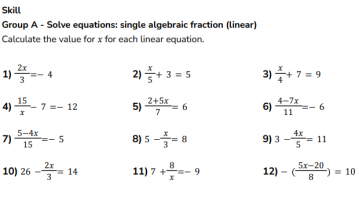You are using an out of date browser. It may not display this or other websites correctly.
You should upgrade or use an alternative browser.
You should upgrade or use an alternative browser.
Order of operations
- Thread starter khris le
- Start date
D
Deleted member 4993
Guest
The short answer is - NO. But it will be useful if you post a problem where you are having doubts.Hi can someone tell me the order of operations specifically when solving for x for different algebraic equations? Is it different to the usual bodmas?
Dr.Peterson
Elite Member
- Joined
- Nov 12, 2017
- Messages
- 16,089
The order of operations is always the same; that refers to evaluating an expression. What changes is what you are doing: In solving, you are commonly "undoing" operations, which you do in reverse order.Hi can someone tell me the order of operations specifically when solving for x for different algebraic equations? Is it different to the usual bodmas?
I compare it to the "order of operations" in getting dressed. You put on your socks first, then your shoes. But in taking them off, you take off the shoes first, then the socks. (Actually, you can take off the socks first, but it hurts your fingers and stretches the sock, so it isn't recommended. The same is true in algebra!)
The point is, the rule doesn't change, because it's an order of doing operations; you're just using it backwards.
Dr.Peterson
Elite Member
- Joined
- Nov 12, 2017
- Messages
- 16,089
As you were asked, please show an example, so we can see where you are making a mistake. When you undo things in a different order, you have to be very careful to do them legally. It's hard to diagnose a problem when you don't show us where it hurts.but I can get a different answer depending on which operation I undo first so sometimes I get the answer wrong.....
I posted one 26 mins ago but it said that message is still waiting for approvalAs you were asked, please show an example, so we can see where you are making a mistake. When you undo things in a different order, you have to be very careful to do them legally. It's hard to diagnose a problem when you don't show us where it hurts.
Here's one 3-(4x/5) = 11 or (2+5x/7) = 6As you were asked, please show an example, so we can see where you are making a mistake. When you undo things in a different order, you have to be very careful to do them legally. It's hard to diagnose a problem when you don't show us where it hurts.
Dr.Peterson
Elite Member
- Joined
- Nov 12, 2017
- Messages
- 16,089
I see post #3 now. But, again, we need to see you WORK in order to know what you are doing wrong.Here's one 3-(4x/5) = 11 or (2+5x/7) = 6
Each can be done in a couple different ways; but, for example, if you do #2 by multiplying first, you need to be sure to multiply every term; subtraction first is more direct. I could guess what mistakes you might be making, but it's better to see the reality.View attachment 32122
These are the questions i'm talking about. Would I do the division/multiplication first or the addition/subtraction?
pka
Elite Member
- Joined
- Jan 29, 2005
- Messages
- 11,971
In both cases I would deal with the fractions first.Here's one 3-(4x/5) = 11 or (2+5x/7) = 6
[imath]5\{3-\left[\dfrac{4x}{5}\right]\}=5(11)\\15-4x=55[/imath]
[imath][/imath][imath][/imath][imath][/imath]
Dr.Peterson
Elite Member
- Joined
- Nov 12, 2017
- Messages
- 16,089
I'll demonstrate a couple ways #2 could be done:Each can be done in a couple different ways; but, for example, if you do #2 by multiplying first, you need to be sure to multiply every term; subtraction first is more direct.
Following the order of operations in reverse, starting with [imath]\frac{x}{5}+3=5[/imath], we would first undo the last operation on the left (addition) by subtracting 3 from both sides; we get [imath]\frac{x}{5}=2[/imath]. Next we would undo the remaining operation (division) by multiply both sides by 5: [imath]5\cdot\frac{x}{5}=5\cdot2[/imath], so that [imath]x=10[/imath].
Often we prefer (as pka showed) to clear fractions first, largely because working with fractions is more error-prone. This time, starting with [imath]\frac{x}{5}+3=5[/imath], we would first multiply both sides by 5. But that means we multiply the entire left side and the entire right side by 5, which many beginners forget to do. That is, we are doing this: [imath]5\left[\frac{x}{5}+3\right]=5[5][/imath]. Distributing on the left, this becomes [imath]5\cdot\frac{x}{5}+5\cdot3=5\cdot5[/imath]; we've multiplied every term. Carrying this out leaves [imath]x+15=25[/imath]. Now we undo the remaining operation (addition) by subtracting 15 from both sides, leaving [imath]x=10[/imath].
We get the same result both ways, as long as we do the work correctly. In some cases, as in #5, clearing fractions is the same as following the reverse order of operations, because the last operation performed in evaluating is the division, so you undo that first anyway.

